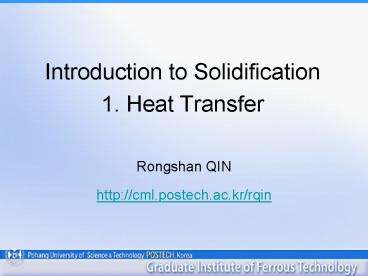Introduction to Solidification 1' Heat Transfer - PowerPoint PPT Presentation
1 / 27
Title:
Introduction to Solidification 1' Heat Transfer
Description:
... due to filling of the mold. ... The thermal radiation power of black body is. is the Stefan ... Laboratory black body. In summary. Basic definitions of heat ... – PowerPoint PPT presentation
Number of Views:295
Avg rating:3.0/5.0
Title: Introduction to Solidification 1' Heat Transfer
1
Introduction to Solidification1. Heat Transfer
- Rongshan QIN
- http//cml.postech.ac.kr/rqin
1
2
(No Transcript)
3
In this lecture
- Heat
- Temperature
- The ways of heat transfer
- Heat transfer in solidification
4
What is heat?
- Heat is a form of energy created by motion of
atoms and molecules.
5
What is temperature?
- Temperature measures the average kinetic energy
of random motion of atoms and molecules
6
Heat transfer
- Heat transfers from one body/location to another
due to a difference in temperature. - Heat transfers spontaneously from high
temperature to low temperature areas. - Heat cannot transfer from a low temperature
object to high temperature object without a heat
pump
7
Heat transfer modes
- Conduction
- Media solid, liquid or gas
- Convection
- Media no solid
- Thermal radiation
- No media. Electromagnetic wave.
8
Heat conduction
- Solid Phonons and electrons
- Liquid Phonons, electrons and transversal
motion. - Gas Motion and collision.
9
Heat conduction
10
Heat conduction
- The rate of heat transfer by conduction Q
k - thermal conductivity.
11
Table 1. Thermal conductivity
12
Heat conduction
- Thermal resistance
13
Heat conduction by composite media
14
Fouriers 1st law of heat conduction
- qQ/A is the rate of heat transfer per unit
cross-sectional area, or heat flux.
- The negative sign represents that heat flows in
the direction opposite to temperature gradient
15
One dimensional solidification
- The generated heat due to heat of fusion in
solidification will be conducted away from
interface to solid and liquid bulk phases.
16
- Interface migration rate
- Single crystal growth
- Interface stability
- Maximum pulling speed
17
Fouriers 2nd law of heat conduction
- Consider an infinite small volume in a thermal
conductor - heat conduction through the surface of the volume
- The rate of heat generation inside
- The heat storage due to temperature change
18
Fouriers 2nd law of heat conduction
where ??c/k is the thermal diffusivity
19
1D steady state heat conduction
Taxb
20
1D unsteady state heat conduction
21
Heat transfer by convection
- Convection can be caused by
- Residual flow due to filling of the mold.
- External forces such as imposed pressure
gradients, mechanical stirring or magnetic
forces. - Density changes due to solidification as well as
due to temperature and chemical compositional
changes. - Surface tension gradients.
- Buoyancy driven flow.
- Dragging force due to solid motion.
22
Heat transfer by convection
- Heat convection possesses much larger heat
transfer rate than heat conduction. - Free convection is normally due to the
temperature-density relationship. - Forced convection is accelerated by external
forces.
23
Newtons law of cooling
- The rate of heat transfer from an object to the
surround fluid by convection is given by
Q is the rate of heat transfer by convection to
the surrounding fluid. A is the objects exposed
area. T? and TW are the fluid free-stream
temperature and object temperature, respectively.
h is the convection heat transfer coefficient.
24
Thermal radiation
- The thermal radiation is by electromagnetic wave
propagation. - There is no medium needed for thermal radiation
- The thermal radiation power of black body is
? is the Stefan-Boltzmann Constant.
25
Thermal radiation
- The thermal radiation power of no-black body
where ? is emissivity of the material
Laboratory black body
26
In summary
- Basic definitions of heat and temperature.
- Three modes of heat transfer
- Fouriers laws of heat conductions
- Application of heat transfer in solidification
- Pulling single crystal
- Sand casting
27
References
- R.V. Kumar, Heat and mass transfer, Cambridge.
- C. Beckermann and R. Viskanta, Appl. Mech. Rev.,
46 (1993) 1-27. - M.C. Flemings, Solidification processing, 1974.

